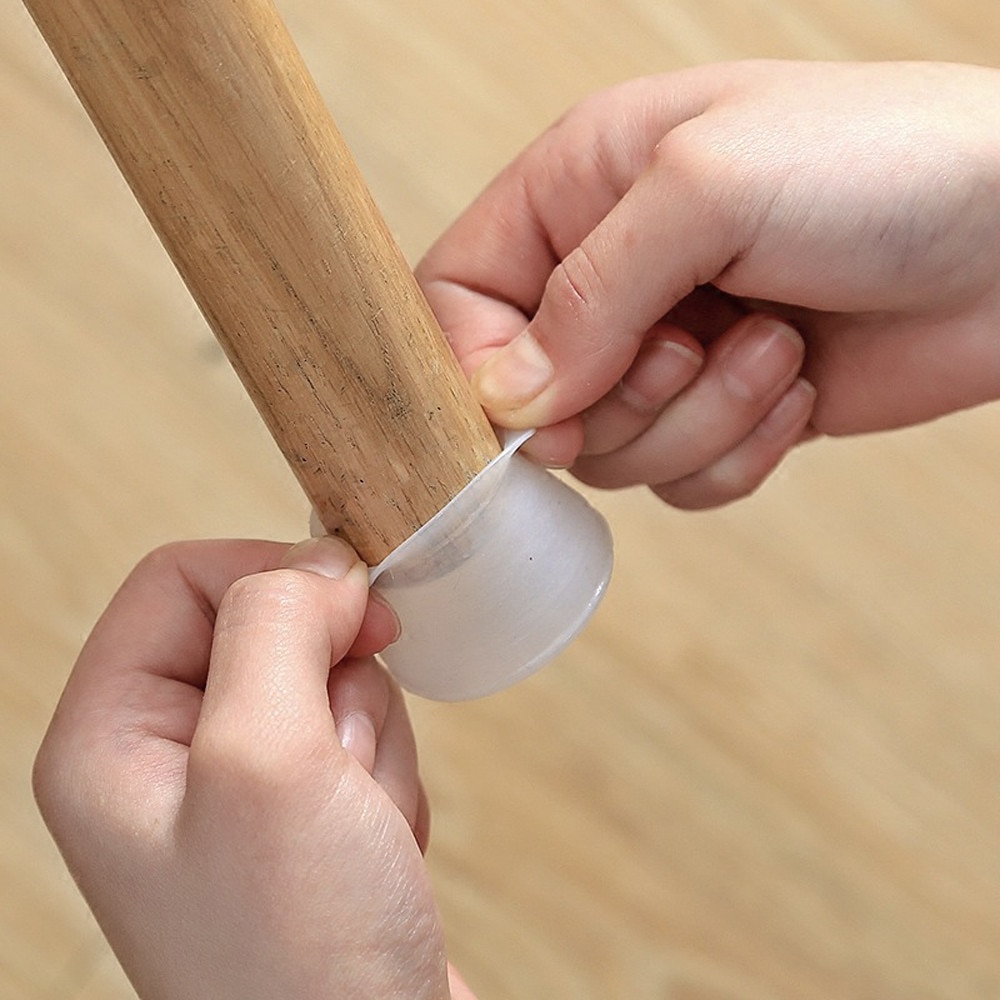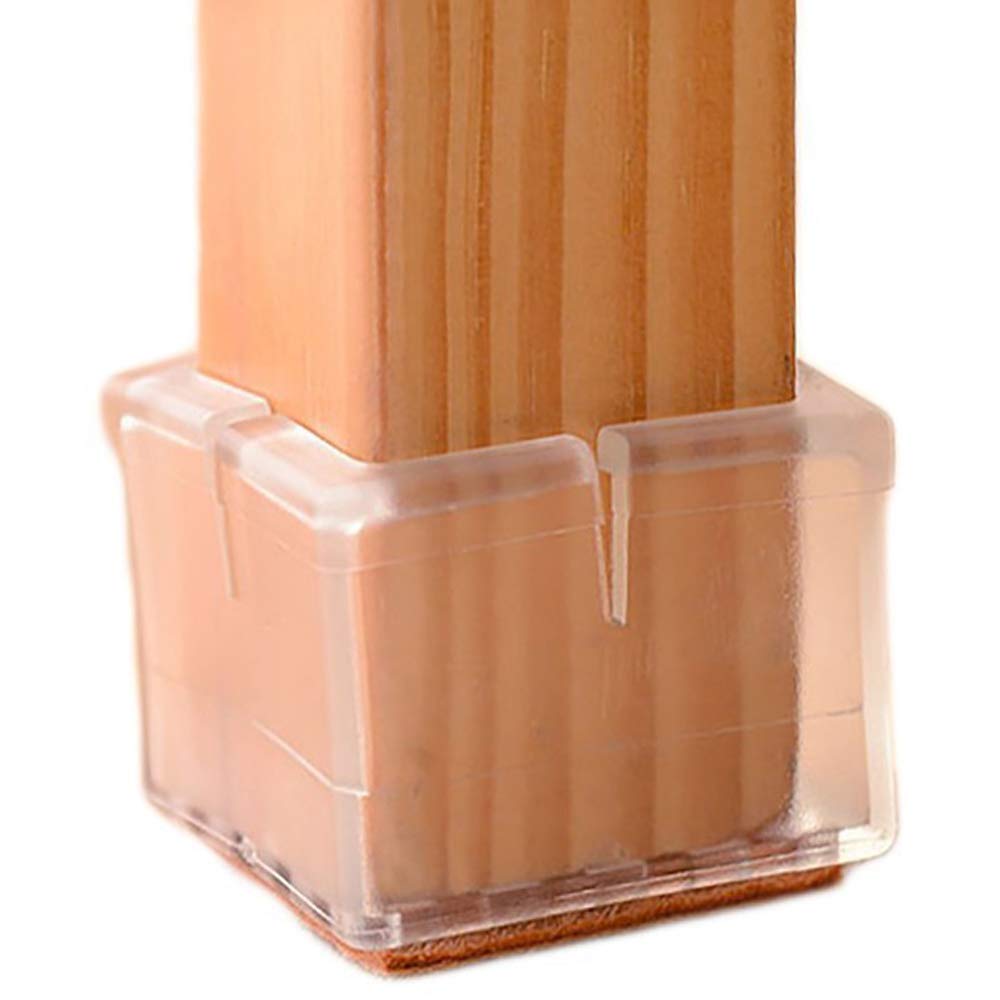Types of Dining Chair Leg Floor Protectors

Dining chair leg floor protectors are essential for safeguarding your floors from scratches, dents, and wear and tear. These protectors come in various materials, each offering unique advantages and disadvantages. Choosing the right type depends on your floor type, the weight of your chairs, and your desired level of protection.
Materials Used for Dining Chair Leg Floor Protectors
The materials used for dining chair leg floor protectors play a crucial role in their performance and aesthetics. Some of the most common materials include:
- Felt: Felt is a soft, porous material made from compressed fibers. It is known for its excellent noise reduction properties and its ability to protect delicate floors like hardwood. Felt protectors are typically affordable and come in various colors. However, felt can be prone to wear and tear, especially in high-traffic areas, and may not provide sufficient grip on smooth surfaces.
- Rubber: Rubber is a durable and resilient material that offers excellent grip and protection. Rubber protectors are often used for heavier chairs and are effective at preventing scratches and dents on hard floors. However, rubber can be noisy, especially on hard surfaces, and may not be suitable for delicate floors like laminate.
- Plastic: Plastic is a versatile and affordable material that comes in various shapes and sizes. Plastic protectors are often lightweight and easy to install. They are suitable for both hard and soft floors and offer good protection against scratches. However, plastic protectors can be less durable than other materials and may not provide sufficient grip on smooth surfaces.
- Silicone: Silicone is a flexible and durable material that offers excellent grip and noise reduction. Silicone protectors are often transparent or translucent, making them suitable for delicate floors. They are also resistant to heat and moisture, making them a good choice for kitchens and bathrooms. However, silicone protectors can be more expensive than other materials.
Comparison of Material Advantages and Disadvantages
Here is a table summarizing the advantages and disadvantages of different materials used for dining chair leg floor protectors:
| Material | Advantages | Disadvantages |
|---|---|---|
| Felt | Soft, quiet, affordable, various colors | Not very durable, may not provide sufficient grip on smooth surfaces |
| Rubber | Durable, good grip, protects against scratches and dents | Can be noisy on hard surfaces, may not be suitable for delicate floors |
| Plastic | Versatile, affordable, easy to install | Less durable than other materials, may not provide sufficient grip on smooth surfaces |
| Silicone | Flexible, durable, excellent grip, noise reduction, transparent or translucent | More expensive than other materials |
Suitability of Floor Protectors for Different Floor Types
The suitability of a floor protector depends on the type of floor you have. Here is a guide to help you choose the right type of protector for your floor:
| Floor Type | Recommended Floor Protector Material |
|---|---|
| Hardwood | Felt, silicone, plastic |
| Tile | Rubber, plastic, silicone |
| Carpet | Felt, plastic |
Benefits of Using Dining Chair Leg Floor Protectors

Dining chair leg floor protectors are small but mighty accessories that can significantly improve the longevity and aesthetics of your home. By adding a layer of protection between your furniture and your flooring, these simple additions can save you from costly repairs and keep your space looking its best.
Preventing Scratches and Damage
Floor protectors act as a barrier between your chair legs and your flooring, effectively preventing scratches, dents, and other forms of damage. This is especially important for delicate surfaces like hardwood floors, laminate, or tile, which are susceptible to wear and tear from chair legs.
- Hardwood floors: These floors are particularly prone to scratches from chair legs, especially if they are made of softwood like pine or oak. Floor protectors can help prevent these scratches, keeping your floors looking beautiful for years to come.
- Laminate flooring: Laminate flooring is a popular choice for its durability and affordability. However, it can still be scratched by chair legs, especially if the legs are made of metal or have sharp edges. Floor protectors can help prevent these scratches and keep your laminate flooring looking new.
- Tile floors: Tile floors are generally more durable than hardwood or laminate floors. However, they can still be scratched or chipped by chair legs, especially if the legs are heavy or have sharp edges. Floor protectors can help prevent these scratches and chips, keeping your tile floors looking beautiful for years to come.
Reducing Noise and Vibration
Floor protectors can significantly reduce the noise and vibration generated when moving chairs. This is because they create a cushion between the chair legs and the floor, absorbing the impact and preventing the noise from traveling through the floor. This is particularly beneficial in open-plan homes or apartments, where noise can easily travel between rooms.
- Hardwood floors: Hardwood floors are known for their beautiful appearance, but they can also be quite noisy. When chair legs are dragged across hardwood floors, they can create a loud scraping sound. Floor protectors can help to muffle this sound, making it more pleasant to move chairs around your home.
- Laminate flooring: Laminate flooring can also be quite noisy, especially if it is not installed properly. Floor protectors can help to reduce the noise of moving chairs on laminate flooring, making it more comfortable for you and your family.
- Tile floors: Tile floors can also be noisy, especially if they are not properly grouted. Floor protectors can help to reduce the noise of moving chairs on tile floors, making it more pleasant to move around your home.
Extending the Lifespan of Furniture and Floors
By protecting your floors from scratches and damage, floor protectors can also help to extend the lifespan of your furniture. This is because scratches and dents on furniture can weaken the structure of the furniture and make it more susceptible to further damage.
- Chair legs: Chair legs are particularly susceptible to damage from scratches and dents. Floor protectors can help to prevent these damages, keeping your chairs looking new for years to come.
- Floor surfaces: Floor protectors can also help to extend the lifespan of your floors. By preventing scratches and dents, floor protectors can help to keep your floors looking beautiful for years to come.
Choosing the Right Dining Chair Leg Floor Protectors

Selecting the perfect floor protectors for your dining chairs is a breeze once you understand the factors involved. This guide will help you navigate the process, ensuring you choose the right protectors for your needs and preferences.
Measuring Chair Legs
Before you can choose the right floor protectors, you need to know the size and shape of your chair legs. This will ensure a snug fit and prevent any slippage or movement. Here’s a step-by-step guide to measuring your chair legs:
1. Gather your tools: You’ll need a measuring tape and a pen and paper to record your measurements.
2. Determine the shape: Identify the shape of your chair legs. Are they round, square, rectangular, or a different shape?
3. Measure the diameter or width: For round or square legs, measure the diameter or width of the leg. For rectangular legs, measure both the width and length.
4. Measure the height: Measure the height of the leg from the bottom to the point where it meets the chair seat.
5. Record your measurements: Write down the measurements for each leg.
Installing Floor Protectors
Once you have the right size and shape of floor protectors, installing them is relatively straightforward. The installation process may vary depending on the type of protector you choose:
Self-Adhesive Floor Protectors:
1. Clean the leg: Wipe the chair leg with a damp cloth to remove any dirt or debris.
2. Peel off the backing: Remove the adhesive backing from the floor protector.
3. Align and press: Align the floor protector with the bottom of the chair leg and press firmly to secure it.
Slip-On Floor Protectors:
1. Stretch the protector: Stretch the floor protector slightly to make it easier to slip over the chair leg.
2. Slide the protector on: Slide the floor protector over the leg until it reaches the desired position.
Screw-On Floor Protectors:
1. Pre-drill holes: If necessary, pre-drill holes in the chair leg to make installation easier.
2. Screw the protector on: Align the protector with the leg and screw it in place using the provided screws.
Factors to Consider When Selecting Floor Protectors
Here are some important factors to consider when choosing the right floor protectors for your dining chairs:
- Budget: Floor protectors come in a wide range of prices, from budget-friendly options to more premium choices. Determine how much you’re willing to spend before you start shopping.
- Aesthetic Preferences: Consider the style of your dining chairs and the overall decor of your dining room. Choose protectors that complement the look of your furniture and blend seamlessly with your existing decor.
- Level of Protection: Some floor protectors offer basic protection, while others provide a higher level of protection against scratches and dents. Consider the type of flooring in your dining room and the amount of wear and tear your chairs are likely to experience. For example, if you have hardwood floors, you might want to choose protectors that offer a higher level of protection to prevent scratches.
- Ease of Installation: Some floor protectors are easier to install than others. Consider your level of DIY expertise and choose protectors that are easy to install and remove.
Dining chair leg floor protectors are a must-have for anyone who wants to keep their floors looking their best. They can prevent scratches, dents, and other damage caused by chair legs. If you’re looking for a stylish and durable dining chair, the sag harbor dining chair is a great option.
No matter what type of chair you have, floor protectors will help keep your floors looking great for years to come.
Dining chair leg floor protectors are a must-have for anyone who wants to keep their floors looking pristine. They can prevent scratches and dents, and they also help to reduce noise when you’re moving your chairs around. If you’re looking for a stylish and comfortable chair to go with your floor protectors, you might want to consider a coaster dining side chair.
These chairs are often made with durable materials and have a sleek design that can complement any decor. No matter what type of chair you choose, make sure you have some floor protectors on hand to keep your floors looking their best!
